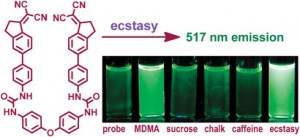An on the spot detector for ecstasy tablets has been made by scientists in Spain. The probe has been designed to detect the active ingredient in ecstasy – MDMA (3,4-methylenedioxymethamphetamine) – even when it is mixed with other common additives, which has been a challenge.
One way to detect ecstasy is a colorimetric test, but the test is not specific for MDMA and is unable to distinguish it from amphetamine and other common phenethylamines. Another method is chromatography, which can distinguish between these compounds but isn’t portable. Now, Tomás Torroba and his team from the University of Burgos have made a fluorimetric compound that can be used to identify MDMA. ‘The fluorogenic probe may be used as an in situ test for fast detection. It only needs a small sample and can be checked with a portable ultraviolet lamp,’ says Torroba.
The probe – a diaryl urea tagged with two fluorescent indicator units – is selective for primary and secondary amines, so it can only reveal that a primary or secondary amine is present. ‘It would be difficult to distinguish the difference between amphetamine or MDMA by the naked eye,’ says Torroba. ‘A mathematical trick is required.’

The fluorogenic probe (structure shown) was developed to detect MDMA from ecstasy tablets, even when it's mixed with other common additives such as sucrose, chalk and caffeine, showing a green fluorescent emission at 517nm
Read the full story in Chemistry World
Link to Journal Article
A turn-on fluorogenic probe for detection of MDMA from ecstasy tablets
Daniel Moreno , Borja Díaz de Greñu , Begoña García , Saturnino Ibeas and Tomás Torroba
Chem. Commun., 2012, Advance Article
DOI: 10.1039/C2CC17823K










